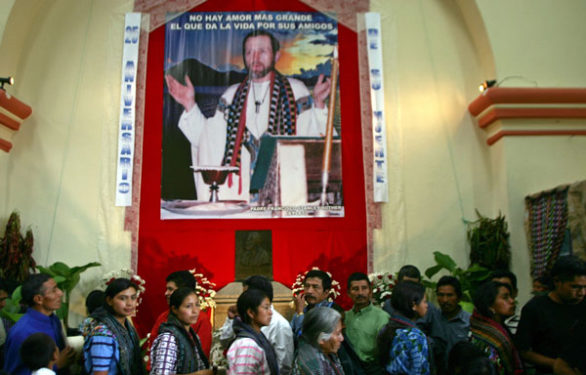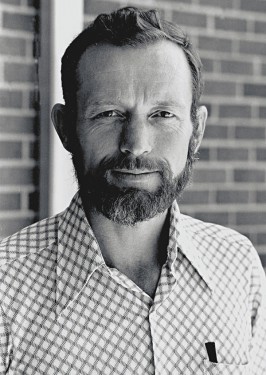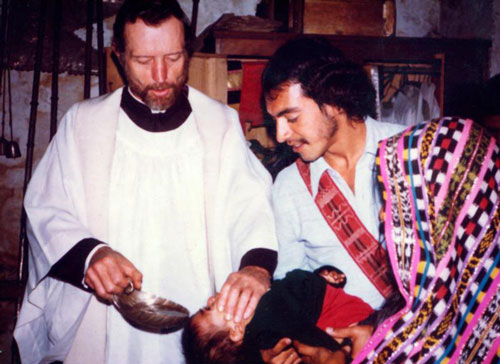
By Father John Vesey
The parish community of Santiago Atitlan, Guatemala, will gather Sept. 23 in the church where its martyr-pastor, Padre Francisco (Blessed Stanley Rother), served them. They will rejoice that the Church has finally acknowledged what they have celebrated for years, his holiness.
Meanwhile, in Oklahoma City, the archdiocese and Catholics from all over the United States will gather to celebrate the beatification of the first American-born priest-martyr of the Catholic Church with the celebration of Mass by Cardinal Angelo Amato, S.D.B. of the Congregation for the Causes of Saints.
Since the martyrdom of Padre Francisco on July 28, 1984, the parish of Santiago Atitlan has celebrated every anniversary of his martyrdom with an all-night prayer vigil service followed by a concelebrated Mass with bishops and priests from all over Guatemala and with thousands of Padre Franciso’s Tz’utujil family.
In the middle of the church, the parish leaders place the coffin that carried his body to the airport. In it, they put his old hat, his shirt and pants, and his pipe. At the head of the coffin, they place his picture and all night long they burn incense and pray for their saintly Father. This was the first public celebration of the death of a martyr in modern Guatemalan history. It was a sign not only of the love of the people of Santiago Atitlan for him, but also a sign of their inner strength and desire to fight with Padre Francisco against the evil that oppressed them.
In Oklahoma City, Cardinal Amato will read the official proclamation announcing the beatification of Blessed Stanley Francis Rother while the Tz’utujil people will celebrate that Padre Francisco is now also recognized in the universal Church.
Not an Easy Road
Father Rother’s road to the priesthood was not an easy one. He worked on his parents’ farm in Okarche, Okla. Sunday Mass at Holy Trinity Church in Okarche was the most important event of the week for the Rother family. But when he decided to enter the seminary, his family was a bit sad because they had hoped he would follow his father’s footsteps and become a farmer. When he entered the seminary, his sister, Marita, became a member of the Sister Adorers of the Blood of Christ.
In his first year of theology, Father Rother did so poorly that the rector sent him home because of his inability to achieve minimum academic standards, mainly due to his inability to learn Latin. After his expulsion from the seminary, Bishop Victor J. Reed asked him to move, for three months, to the new as yet unopened seminary in Oklahoma City so that he could help prepare the building for the seminary’s opening. Then Bishop Reed, who had a doctorate from Rome and another from Louvain, saw something in this young seminarian.

After three months, in September 1959, he sent Rother to Mount St. Mary’s Seminary in Emmitsburg, Md., to continue his studies for the priesthood. He was ordained a priest on May 25, 1963 at the Cathedral of Our Lady of Perpetual Help in Oklahoma City.
His first assignment in July 1963, was in a small town in southern Oklahoma where the diocese had a tract of land. Bishop Reed asked Father Rother to make improvements on this property. He built a seven-bedroom lodge, two smaller guesthouses and a caretaker’s house for the diocese. He did this with no master plan, no wealthy patrons or outside resources.
In the spring of 1968, Father Ramon Carlin recruited Father Rother for the Oklahoma Mission (Micatokla – Mission Catholic Oklahoma) in Santiago Atitlan. At that time, the mission team included five other priests, three papal volunteers, and three women religious. His mechanical skills were immediately put to use in making repairs to the rectory. From 1968 to 1970, he, with help, built a small hospital, installed the electrical wiring in the rectory property, and dug a well to provide water for the rectory and the church.
Though he could speak neither Spanish nor Tz’utujil when he arrived, he began studying Spanish in November 1968. In October 1969, he began studying Tz’utujil, one of the most difficult of the indigenous languages. In three years, he began preaching in Tz’utujil in spite of “problems he had learning Latin.”
In 1970, Micatokla bought some land and Father Rother became the agronomist of the area. He experimented with different plants and fertilizer in an attempt to help people improve their harvests. Though he continued to devote a great deal of time to the maintenance and repair of vehicles and buildings and the land, he never neglected the pastoral work.
Political Strife
In the 1970s, there was a great deal of political strife throughout Guatemala but especially in the indigenous villages. The ruthless political military establishment served the interests mainly of foreign companies and those of the Guatemalan elite, and oftentimes served the interests of the American government.
The Church’s preferential option for the poor, guided by the social doctrine of the Church, made it a target as it was seen as the enemy of the status quo because it sided with the indigenous populations and the poor.
In May 1979, Father Rother’s name appeared on an anonymous hate sheet being circulated in the area.
Prior to the July 25, 1980 parish festival (the Feast of St. James the Apostle), members of the Guatemalan army spent time in Santiago Atitlan asking questions and threatening the people. Prominent Tz’utujil began leaving the area in search of safer havens. Father Rother strengthened the security of the parish buildings and kept the front door of the rectory locked at all times. He moved his bed to the first floor of the rectory because it had walls made of stone rather than wood.

On Jan. 8, 1981, following a massacre of innocent people in his parish, Father Rother went to the pastoral center in Panajachel for a meeting of the priests and nuns of the Diocese of Solola. He asked for a public condemnation of the terror and killing of the people.
On Jan. 12, one of the priests of the diocese who had a government source informed Father Rother that his life was in danger and that the government would try to kill him. Bishop Angelico Melotto, the diocesan bishop, advised Father Rother to go home for a while and he did.
Father Rother returned to Guatemala in 1981. His friends in the American Embassy told him that he should not go back to Santiago Atitlan. When he met Bishop Melotto in Guatemala City, the bishop told him: “Don’t go back to Santiago Atitlan now. It is too dangerous.”
Father Rother replied, “My life is for my people. I am not scared.”
Father Rother was warned that the government had decided to kill him. One night, the watchman told Father Rother that he had overheard that there would be an attempt to kill him. About 1:30 a.m. on July 28, three Spanish Ladinos (non-indigenous) entered the rectory using a key obtained from an unknown source, an obvious indication that even those close to Padre Francisco were willing to betray him.
The intruders looked for Father Rother and realized that he had changed his sleeping quarters. Finally, they knocked on the door of the room where he was sleeping.
When he opened the door, the men seized him and tried to take him away but he was too strong for the three of them. The men shot him twice in the head and Padre Francisco died where he had lived.
The beatification of Padre Francisco is a gift to the universal Church and especially to the Churches of Guatemala and the United States.
On Feb. 6, 1996, the Guatemalan bishops asked Pope John Paul II to canonize 77 Guatemalan martyrs. On that day, Father Stanley Francis Rother’s name was not included in that list, even though he was the only martyr celebrated by the local community since the day of his death.
Wisely, the Church of Oklahoma asked for permission to present his cause for beatification. Pope Francis granted this request and now we are celebrating the beatification of this American martyr. However, those who suffered with him, the native martyrs of Guatemala, have not yet been recognized officially by the Church. Prayers and a great deal of work by the Church in Guatemala has to be done so that the lives of these holy men and women can be raised up to us as examples of holiness.
The beatification of Blessed Stanley Francis Rother, Padre Francisco, could be the grace that the Church in Guatemala needs so that she may renew her efforts in favor of the martyrs that the Lord has bestowed on her. As the Church in Oklahoma and in the United States rejoice in the beatification of Blessed Stanley Rother, may it also be a time of renewal of its own missionary vocation. May the Church stand with all who suffer persecution today for their faith and in their struggle for human dignity.
For a deeper understanding of the life of Blessed Stanley Rother, one can read the historical commission report to the Congregation for the Causes of Saints on the life of the Servant of God, Reverend Stanley Rother and Father Stanley Rother’s letters in “The Shepherd Cannot Run.”
Father Vesey, a Brooklyn priest, also served as a missionary in Guatemala.
